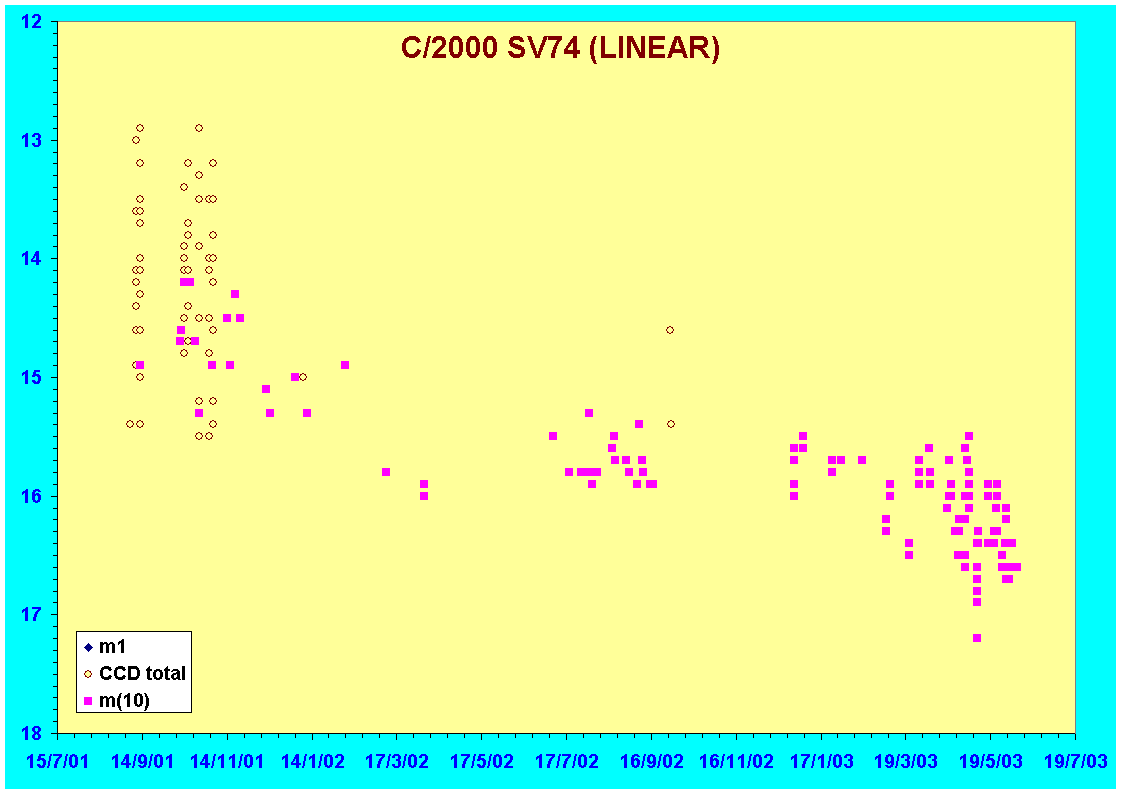C/2000 SV74 (LINEAR)
C/2000 SV74
(LINEAR) is another of the many objects that have been reported by LINEAR as an
asteroid, in this case of magnitude 17.8, but that are later found to show
cometary activity.
The initial observation was
made on September 24th 2000 and the object designated 2000 SV74. On October
19th 2000 Milos Tichy noticed a 16" coma and 20" tail on an exposure
with the 57-cm reflector at Klet Observatory in the Czech Republic. Later, 5
images of the object were found on LINEAR exposures taken on September 5th
2000.
The comet has a quite
strongly hyperbolic orbit (e=1.0048) with perihelion at 3.54AU on April 30th
2002. It has a strongly inclined orbit (i=75º) with perihelion over the north
pole of the Earth. As the comet receeds from perihelion it will drop into the
southern hermisphere and will finish in the southern polar regions in 2004.
In April 2003 this comet is
still showing a well-developed coma despite its large and rapidly increasing
heliocentric distance.
The light curve
 The CCD Total magnitudes are measured with
apertures from 12" to 1.1' and with V, R & I filters. The measures
show a large difference in brightness between apertures. This is indicative of
a relatively large and difuse object. With a low degree of central condensation
the light is spread over a wide area of sky.
The CCD Total magnitudes are measured with
apertures from 12" to 1.1' and with V, R & I filters. The measures
show a large difference in brightness between apertures. This is indicative of
a relatively large and difuse object. With a low degree of central condensation
the light is spread over a wide area of sky.
Giovanni Sostero notes that
the (R-I) colour index that he measures is +0.6, compared to the solar value of
+0.4. This indicates that the comet's coma is slightly redder than solar
colours due to scattering of light in the coma. The (R-I) colour index is though
closer to solar (+0.5) in larger apertures.
The absolute magnitude is
nominally quite bright (3.0), although this is partly due to the fact that the
comet has a somewhat more rapid rate of brightening (5th power law) with
increasing heliocentric distance.
C/2000 SV74 (LINEAR) should
stay quite close to its maximum brightness all through 2003, although it is
obvious that there is a slow, but systematic fade. This fade appears to have
accelerated since late March.
CCD observations in a 10
arcsecond aperture by:
- Isidro Almendros – MPC 212
- Ramón Naves & Montse Campàs - MPC 213
- Esteban Reina – MPC 232
- Rolando Ligustri - MPC 235
- Albert Sánchez - MPC 442
- Miguel Camarasa - MPC 445
- Julio Castellano – MPC 939
- Fernanda Artigue & Mark Kidger – MPC 954
- Francesc Baldrís – MPC A01
- Josep Lluís Salto – MPC A02
- Quim Moreno – MPC A03
CCD aperture photometry in
apertures of 0'.2, 0'.3, 0'.5, 0'.6, 0'.7, 0'.8, 1'.1 by:
- Giovanni Sostero
- R. Ligustri
- P.Beltrame
- M.Narduzzi
- G.Degano
- V.Savani
Última actualización 12/06/2003
Por M.R.Kidger